This article was medically reviewed by Joshua Batt, DO. Dr. Batt is an Emergency Medicine Physician at Riverside Community Hospital in California. He received his D.O. from the Touro University Nevada College of Osteopathic Medicine in 2012. He is a member of the American Osteopathic Association (AOA) and has over 5 years of emergency medicine experience.
There are 24 references cited in this article, which can be found at the bottom of the page.
wikiHow marks an article as reader-approved once it receives enough positive feedback. This article received 13 testimonials and 88% of readers who voted found it helpful, earning it our reader-approved status.
This article has been viewed 572,565 times.
Experts agree that the best way to treat a burn depends on where the burn is located and how severe it is. Although hand burns may be treatable at home, they can be very serious, especially if your burn covers your hand.[1] Research suggests that you should immediately cool down a fresh burn using cool water. Then, cover it with aloe vera gel and apply a sterile non-stick bandage. However, call your doctor if your burn is severe, you inhaled smoke, or you have questions about how to care for your burn.[2]
Steps
Assessing the Situation
-
1Secure your environment. As soon as a burn occurs, stop what you are doing. Make the scene safe by shutting off any open flame or burner so no one else gets hurt. If there is a fire that is out of control, get out of the area as soon as possible and call emergency services.
-
2Call for help. If the fire is out of control in your home, call 911 to get the fire department to your area. Call poison control if you are unsure whether the chemical could cause other side effects. For an electrical burn, call 911 if the wire is still live, or if the burn was caused by a high-voltage wire or a lightning strike.[5]
- If you are unsure if the wire is still live, do not touch it directly. Touch it with a dry, nonconducting source like a dry piece of wood or plastic.[6]
- People who have suffered electrical burns should always seek medical attention, as the electricity can interfere with your body's natural electrical impulses and cause severe side effects.[7]
Advertisement -
3Assess the hand burn. Look at the burned area of the hand to assess the damage. Note the placement of the burn on the hand. Look at the appearance of the burn and note specific characteristics. This will help you decide which type of burn you have. Burns are classified as first-, second-, or third-degree, depending on how deeply they have burned the skin. First-degree burns are the mildest type, while third-degree burns are the worst. Different methods are used to treat burns depending on their degree.[8]
- If the hand burn is on the palm, you should seek prompt medical attention. Burns on the palm could cause long-term disability.[9] [10]
- If you have circumferential burns on your fingers (meaning the burns wrap around any or several fingers), seek prompt medical attention. This type of burn can restrict blood flow and in severe cases could require amputation of the finger if left untreated.[11]
Caring for a First-Degree Burn
-
1Recognize a first-degree burn. First-degree burns only affect the top layer of skin, the epidermis. First-degree burns are a little bit swollen and red. They also are painful. When you press on the skin, they might turn white for a few moments after you release the pressure. If the burn has not blistered or opened but has just reddened the skin, you have a first-degree burn.[12]
- If a mild burn covers the hand as well as the face or airway, most of the hands, feet, groin, buttocks, or over major joints, a trip to the doctor is recommended.
- Sunburns are common first degree burns, unless there is blistering involved.[13]
-
2Treat first-degree burns. If you determine that the burn is first-degree based on the way it looks and feels, quickly but calmly get to a sink. Put your hand or arm under the faucet and run cool water over it for 15-20 minutes. This will help pull heat away from the skin, which will help reduce inflammation.[14]
- You can also take a bowl of cold water and place the affected area in it for a few minutes. This will also help pull heat away from the skin, reduce inflammation, and prevent as much scarring.
- Do not use ice because it can lead to frostbite on the burned skin if it is left on the skin for too long. Also, if the skin around the burn has ice on it, it too can be damaged.[15] [16]
- You should also not apply butter or blow air on the burn. This will not help and can increase your likelihood of infection.[17]
-
3Remove jewelry. Burns can cause swelling, which could cause jewelry on the burned hand to become uncomfortably tight, cut off proper circulation, or dig into the skin. Remove any jewelry on the burned hand, such as rings or bracelets.[18]
-
4Apply aloe or burn ointment. If you have an aloe vera plant, break off one of the lower leaves near the center of the stalk. Slice off the spines, split the leaf lengthwise, and apply the gel directly to the burn. It will immediately provide a cooling relief. This is a good relief for a first-degree burn.
- If you don't have an aloe vera plant, you can use store bought 100% aloe vera gel.
- Do not apply aloe to an open wound.
-
5Take pain medication if needed. Over-the-counter pain relievers such as acetaminophen (Tylenol), naproxen (Aleve), or ibuprofen (Advil, Motrin) are all considered safe for short-term use.[19]
-
6Monitor the burn. Burns can become worse over the course of a few hours. After rinsing and treating your burn, monitor your burn to make sure that it does not develop into a second-degree burn. If it does, consider seeking medical treatment.[20]
Treating a Second-Degree Burn
-
1Recognize second-degree burns. Second-degree burns are more severe than first-degree burns because they extend past the epidermis and into the lower layer of skin (the dermis).[21] This doesn't necessarily mean they need medical care. The burns will be a dark red and will produce blisters on the skin. They are more swollen and splotchy than first-degree, with more reddened skin, which may look wet or shiny. The burned area itself may look white or discolored.[22]
-
2Remove jewelry. Burns can cause swelling, which could cause jewelry on the burned hand to become uncomfortably tight, cut off proper circulation, or dig into the skin. Remove any jewelry on the burned hand, such as rings or bracelets.[25]
-
3Rinse the burn. Treatment for second-degree burns is almost the same as first degree burns. When the burn occurs, quickly but calmly get to a sink and put your hand or arm under the cold water for 15-20 minutes. This will help pull heat away from the skin and reduce inflammation. If blisters are present, do not pop them. They help the skin heal. Popping them can introduce infection and delay healing time.[26]
- Don't apply butter or ice to the burn. Also, do not blow on the burn because it can increase your likelihood of infection.[27]
-
4Apply an antibiotic cream. Because second-degree burns extend further into the skin, the potential for infection is greater.[28] Apply an antibiotic cream to the burned area before bandaging it.
-
5Clean a popped blister. If a blister does pop on its own or by accident, do not panic. Clean it with a mild soap and clean water. Apply an antibiotic ointment and cover the burn with a new bandage.
-
6Apply a new bandage daily. Burn dressings should be changed daily to help prevent infection. Remove the old bandage and throw it away. Rinse the burn in cool water, avoiding soap. Do not scrub the skin. Let the water run on it for a few minutes. Pat dry with a clean towel. Apply burn cream, antibiotic ointment, or aloe vera to the burn to help it heal. Cover with a new sterile bandage.
- When the wound is gone or mostly gone you won't need the bandage anymore.
-
7Make a homemade honey ointment. The use of honey to treat burns is supported by several studies, although doctors consider it an alternative treatment. Take a teaspoon of honey to cover the burn. Dab it on your wound. Honey is naturally antiseptic and keeps bacteria out of the wound, but causes no damage the outside healthy skin. The honey's low PH and high osmolarity helps the healing. Medicinal honey is recommended instead of the kind you bake with.[31]
- Studies have suggested that honey may be a better alternative than regular silver sulfadiazine prescription ointment.[32]
- Dressing changes should happen daily. If the wound drains more often, change the dressing more often.
- If the burn cannot be covered, then reapply the honey every 6 hours. It helps cool the burn as well.[33] [34]
-
8Monitor the burn. Burns can become worse over the course of a few hours. After rinsing and treating your burn, monitor your burn to make sure that it does not develop into a third-degree burn. If it does, seek medical treatment immediately.[35]
- While healing, look for signs and symptoms of infection, such as pus-like oozing from the burn, fevers, swelling, or increased redness on the skin. If these signs occur, seek medical treatment.
Dealing with Third-Degree and Major Burns
-
1Recognize major burns. Any burn can be a major burn if it is over the joints or covering the majority of the body. It is also major if the burned person is having complications with vital signs or difficulty with normal activities because of the burn. These should be treated the same as third-degree burns, with immediate medical attention.[36]
-
2Recognize third-degree burns. If your burn is bleeding or looks a little bit black, you may have a third-degree burn. Third-degree burns burn through all layers of skin: the epidermis, dermis, and the underlying fat. These burns may appear white, brown, yellow, or blackened. The skin may look dry or leathery. They are not as painful as first or second because the nerves have been either damaged or destroyed.[37] These burns require immediate medical attention. Call for emergency services or get to an emergency room.
- These burns can become infected and your skin may not grow back correctly.
- If your clothes are sticking to this burn, do not pull the clothes away. Get help right away.
-
3Respond to the situation. If you or someone near you gets a third degree burn, call 911 immediately. While waiting for EMS to arrive, check to see if the person is responsive. Responsiveness is established by gently shaking the victim. If there is no response, look for signs of movement or breathing. If they are not breathing, start CPR if you have been trained to do so.[38]
- If you do not know how to perform CPR, you can ask the emergency dispatcher to talk you through it.[39] Do not attempt to clear the airway or breathe for the other person if you do not know CPR. Instead, focus only on chest compressions.
- Lie the person on her back. Kneel next to her shoulders. Place your hands over the center of her chest, and move your shoulders so that they are right above your hands with your arms and elbows straight. Push straight down on her chest for about 100 compressions per minute.[40]
-
4Take care of the burn victim. While you are waiting on emergency personnel to arrive, remove any constrictive clothing and jewelry. Do not do this if the clothing or jewelry is stuck in the burn. If this happens, leave it as is and wait for help to arrive. Removing it will pull off skin and cause further injury. You should also keep yourself (or the patient) warm, as these severe burns can cause you to go into shock.[41]
- Do not soak the burn in water, as you would with minor burns. This can lead to hypothermia. If possible, elevate the burn above heart level to help reduce swelling.
- Do not give any pain medication. You do not want to give anything that could interfere with the emergency medical treatment.
- Do not pop blisters, scrape dead skin, or apply aloe or salve.[42]
-
5Cover the burn. If it is possible, you should try to cover the burn so it does not become infected. You need to use something that will not stick to it, such as lightweight gauze or a moistened bandage. If the bandage will stick due to the severity of the burn, wait for EMS.[43]
- You might be able to use plastic wrap. If used for a very temporary amount of time, plastic wrap has been shown to be effective as a dressing. It protects while maintaining a low level of transmission of outside organisms to the burn.[44]
-
6Get treatment at the hospital. When you arrive at the hospital, the staff will move quickly to be sure to treat the burn effectively. They may start an IV to replace any lost electrolytes from your body. They will also clean the burn, which can be very painful. They may give you pain medication. They will apply ointments or creams to the burn, and cover it with a sterile dressing. If needed, they might create a warm, humid environment to help the burn heal.[45]
- They might have a nutritionist suggest a high protein diet to aid with healing.
- If necessary, the physician may talk to you about follow-up skin grafting. Skin grafting is when you take a piece of skin from another part of the body to cover the burnt area.
- Expect the hospital staff to teach you how to do dressing changes at home. After discharge, dressings will need to be changed. Follow-up will continue with the physician to assure adequate healing.[46]
References
- ↑ https://www.mayoclinic.org/diseases-conditions/burns/symptoms-causes/syc-20370539
- ↑ https://www.nhs.uk/conditions/burns-and-scalds/
- ↑ http://www.mayoclinic.org/first-aid/first-aid-chemical-burns/basics/art-20056667
- ↑ http://www.mayoclinic.org/first-aid/first-aid-electrical-burns/basics/art-20056687
- ↑ http://www.mayoclinic.org/first-aid/first-aid-electrical-burns/basics/art-20056687
- ↑ http://www.mayoclinic.org/first-aid/first-aid-electrical-burns/basics/art-20056687
- ↑ http://www.medicinenet.com/burns/page4.htm
- ↑ https://www.urmc.rochester.edu/encyclopedia/content.aspx?ContentTypeID=90&ContentID=P01744
- ↑ http://www.woundsresearch.com/article/1179
- ↑ http://www.emedicinehealth.com/chemical_burns/page4_em.htm#when_to_seek_medical_care
- ↑ http://www.medicinenet.com/burns/page3.htm
- ↑ https://www.urmc.rochester.edu/encyclopedia/content.aspx?ContentTypeID=90&ContentID=P01744
- ↑ http://www.mayoclinic.org/first-aid/first-aid-burns/basics/art-20056649
- ↑ https://www.mayoclinic.org/first-aid/first-aid-burns/basics/art-20056649
- ↑ http://www.sharecare.com/health/skin-burn-treatment/why-shouldnt-treat-burn-ice
- ↑ http://www.mayoclinic.org/first-aid/first-aid-burns/basics/art-20056649
- ↑ http://www.nlm.nih.gov/medlineplus/ency/article/000030.htm
- ↑ http://www.medicinenet.com/burns/page4.htm
- ↑ http://www.mayoclinic.org/first-aid/first-aid-burns/basics/art-20056649
- ↑ http://www.medicinenet.com/burns/article.htm
- ↑ https://www.urmc.rochester.edu/encyclopedia/content.aspx?ContentTypeID=90&ContentID=P01757
- ↑ https://www.urmc.rochester.edu/encyclopedia/content.aspx?ContentTypeID=90&ContentID=P01757
- ↑ http://www.mayoclinic.org/first-aid/first-aid-burns/basics/art-20056649
- ↑ https://www.urmc.rochester.edu/encyclopedia/content.aspx?ContentTypeID=90&ContentID=P01757
- ↑ http://www.medicinenet.com/burns/page4.htm
- ↑ https://www.askdrsears.com/topics/health-concerns/skin-care/burns/
- ↑ http://www.nlm.nih.gov/medlineplus/ency/article/000030.htm
- ↑ https://www.urmc.rochester.edu/encyclopedia/content.aspx?ContentTypeID=90&ContentID=P01757
- ↑ http://www.medicinenet.com/burns/page4.htm
- ↑ http://www.mayoclinic.org/first-aid/first-aid-burns/basics/art-20056649
- ↑ http://www.ncbi.nlm.nih.gov/pmc/articles/PMC4158441/
- ↑ http://www.ncbi.nlm.nih.gov/pmc/articles/PMC3263128/
- ↑ https://www.nursingtimes.net/clinical-archive/tissue-viability/using-honey-dressings-the-practical-considerations-07-12-2000/
- ↑ http://www.ncbi.nlm.nih.gov/pmc/articles/PMC3263128/
- ↑ http://www.medicinenet.com/burns/article.htm
- ↑ https://www.urmc.rochester.edu/encyclopedia/content.aspx?ContentTypeID=90&ContentID=P01760
- ↑ https://www.urmc.rochester.edu/encyclopedia/content.aspx?ContentTypeID=90&ContentID=P01760
- ↑ http://www.mayoclinic.org/first-aid/first-aid-burns/basics/art-20056649
- ↑ https://depts.washington.edu/learncpr/askdoctor.html#What%20should%20I%20do
- ↑ http://www.mayoclinic.org/first-aid/first-aid-cpr/basics/art-20056600
- ↑ https://www.urmc.rochester.edu/encyclopedia/content.aspx?ContentTypeID=90&ContentID=P01760
- ↑ http://www.nlm.nih.gov/medlineplus/ency/article/000030.htm
- ↑ http://www.mayoclinic.org/first-aid/first-aid-burns/basics/art-20056649
- ↑ https://www.nhs.uk/conditions/burns-and-scalds/treatment/
- ↑ https://www.urmc.rochester.edu/encyclopedia/content.aspx?ContentTypeID=90&ContentID=P01760
- ↑ http://www.chw.org/medical-care/burn-program/burn-treatments/classification-and-treatment-of-burns/third-degree-burns/
About This Article
To treat a first degree hand burn, quickly put the affected area under cool running water for 15 to 20 minutes to reduce inflammation. Then, apply an aloe vera gel or a burn ointment for immediate cooling relief. Monitor your injury for signs, like blisters or wet looking skin, which may indicate a second degree burn. In that case, use antibiotic cream to decrease your risk of infection. However, make sure to seek medical attention if you notice signs of infection, like pus, fever, or swelling. To learn how to treat a third degree burn, keep reading!
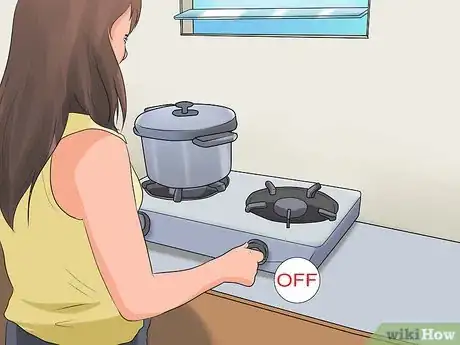



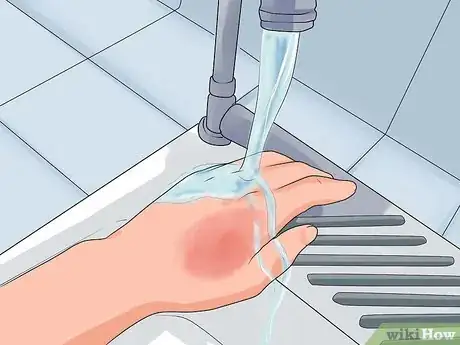
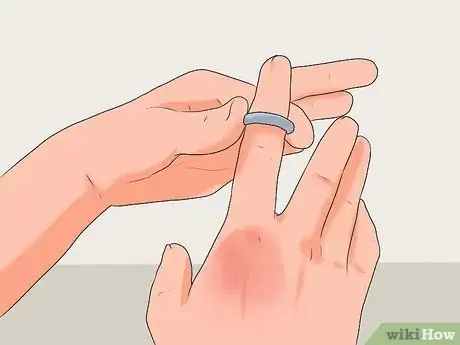
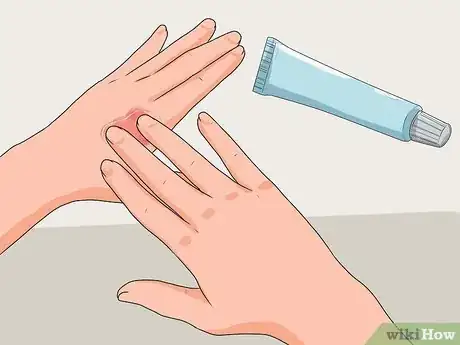
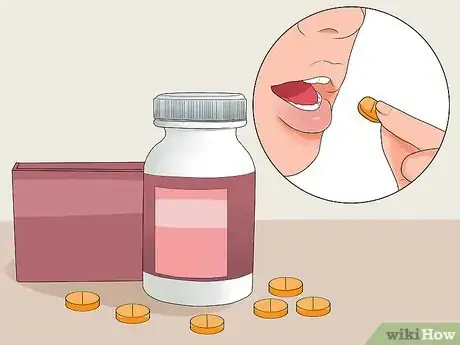


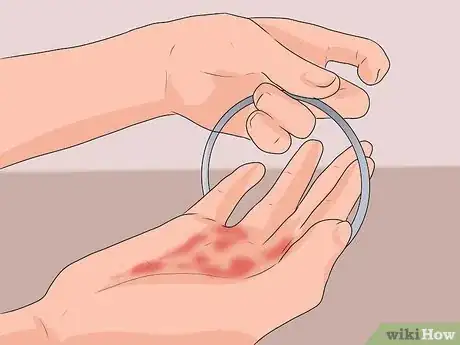
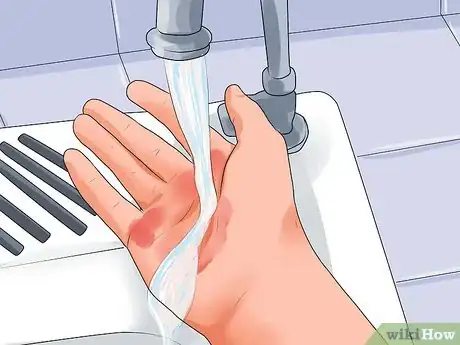
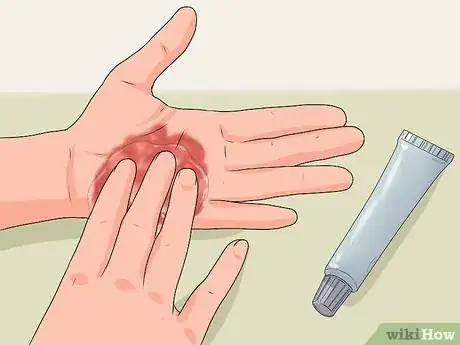


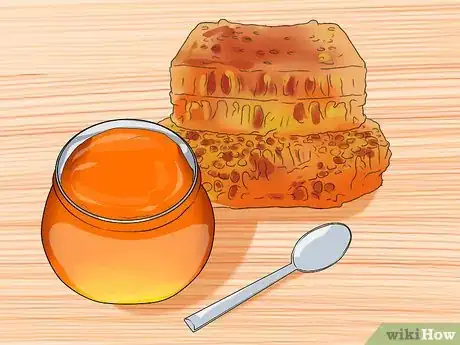
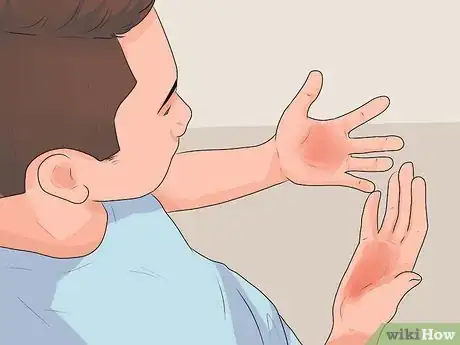




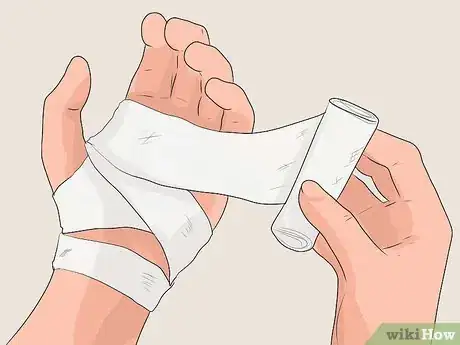
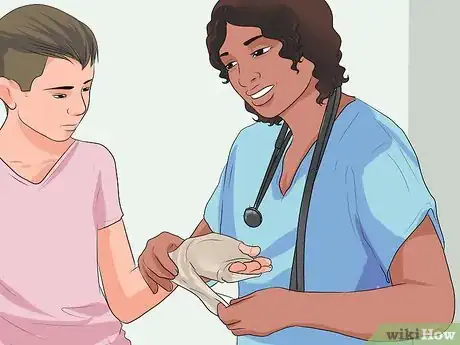


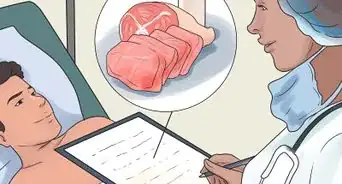
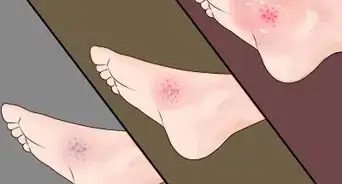
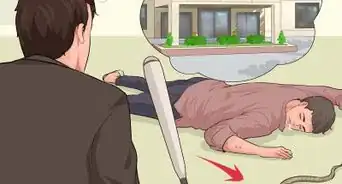
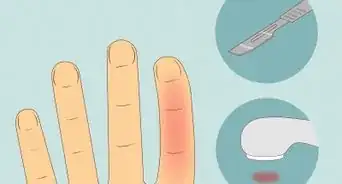
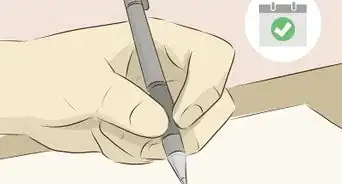
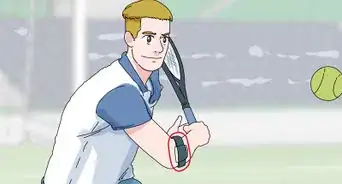
-Step-15-Version-3.webp)
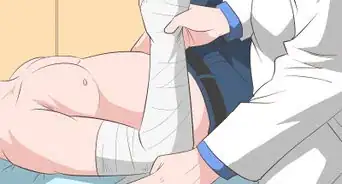


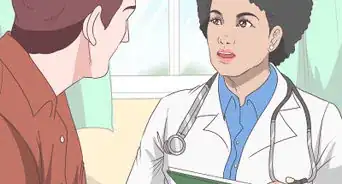
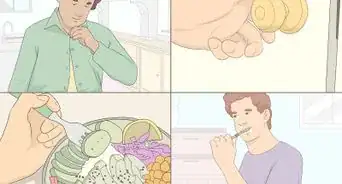














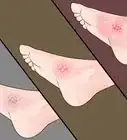



































Medical Disclaimer
The content of this article is not intended to be a substitute for professional medical advice, examination, diagnosis, or treatment. You should always contact your doctor or other qualified healthcare professional before starting, changing, or stopping any kind of health treatment.
Read More...